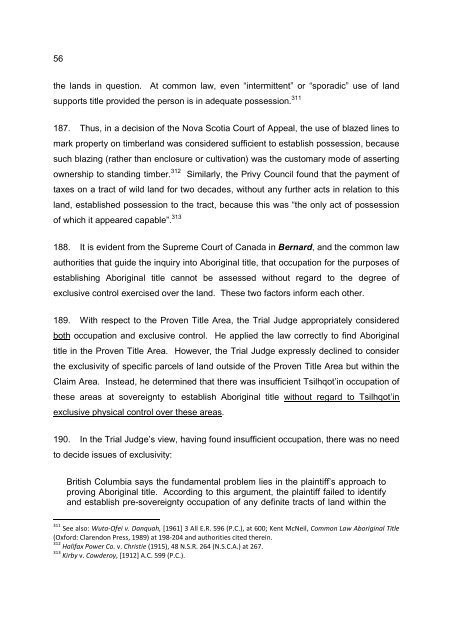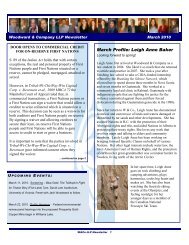Appellants factum - Woodward & Company
Appellants factum - Woodward & Company
Appellants factum - Woodward & Company
Create successful ePaper yourself
Turn your PDF publications into a flip-book with our unique Google optimized e-Paper software.
56the lands in question. At common law, even “intermittent” or “sporadic” use of landsupports title provided the person is in adequate possession. 311187. Thus, in a decision of the Nova Scotia Court of Appeal, the use of blazed lines tomark property on timberland was considered sufficient to establish possession, becausesuch blazing (rather than enclosure or cultivation) was the customary mode of assertingownership to standing timber. 312 Similarly, the Privy Council found that the payment oftaxes on a tract of wild land for two decades, without any further acts in relation to thisland, established possession to the tract, because this was “the only act of possessionof which it appeared capable”. 313188. It is evident from the Supreme Court of Canada in Bernard, and the common lawauthorities that guide the inquiry into Aboriginal title, that occupation for the purposes ofestablishing Aboriginal title cannot be assessed without regard to the degree ofexclusive control exercised over the land. These two factors inform each other.189. With respect to the Proven Title Area, the Trial Judge appropriately consideredboth occupation and exclusive control. He applied the law correctly to find Aboriginaltitle in the Proven Title Area. However, the Trial Judge expressly declined to considerthe exclusivity of specific parcels of land outside of the Proven Title Area but within theClaim Area. Instead, he determined that there was insufficient Tsilhqot’in occupation ofthese areas at sovereignty to establish Aboriginal title without regard to Tsilhqot’inexclusive physical control over these areas.190. In the Trial Judge’s view, having found insufficient occupation, there was no needto decide issues of exclusivity:British Columbia says the fundamental problem lies in the plaintiff’s approach toproving Aboriginal title. According to this argument, the plaintiff failed to identifyand establish pre-sovereignty occupation of any definite tracts of land within the311 See also: Wuta-Ofei v. Danquah, [1961] 3 All E.R. 596 (P.C.), at 600; Kent McNeil, Common Law Aboriginal Title(Oxford: Clarendon Press, 1989) at 198-204 and authorities cited therein.312 Halifax Power Co. v. Christie (1915), 48 N.S.R. 264 (N.S.C.A.) at 267.313 Kirby v. Cowderoy, [1912] A.C. 599 (P.C.).



